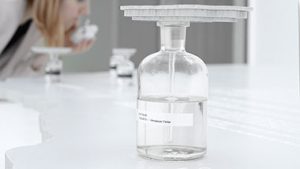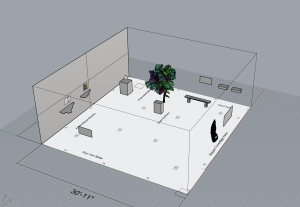
Sensoria: The Art and Science of Our Senses is a multi-site exhibition and hybrid symposium that bridges LAZNIA Centre for Contemporary Art (LCCA) in Gdansk, Poland and Sensorium: Centre for Digital Arts & Technology at York University in Toronto, Canada. Held simultaneously in both locations, the exhibition and symposium will engage multi-sensory research that revitalizes our sensory connections to our surroundings, through and despite technological tools, networks and latencies.
EXHIBITION
September 26 – October 14, 2022
Gales Gallery, York University
105 Accolade West Building,
86 Fine Arts Road, Toronto, ON
Sensoria: The Art and Science of Our Senses is co-curated by distinguished curator Nina Czegledy (Agents for Change: Facing the Anthropocene, 2020 & Leonardo/ISAST 50th Celebrations, 2018) and Sensorium director Joel Ong, with the support of assistant curators Eva Lu and Cleo Sallis-Parchet. Sensoria explores the intersection of art, science and the senses, bringing together an international network of artists: Guy van Belle, Roberta Buiani, Lorella Di Cintio, Grace Grothaus, Kavi, Hrysovalanti Maheras, Agnes Meyer-Brandis, Gayil Nalls, Michael Palumbo, Michaela Pnacekova, Raewyn Turner and Brian Harris. Sited concurrently in both Poland and Toronto, the exhibition will explore the dissociative potential of contemporary technologies on the senses, treating it not only as a social crisis but also an opportunity for creative play and experimentation. It aims to engage a conversation about the senses from the perspective of art, but also science, incorporating artists that straddle the boundaries of knowledge production in a variety of ways.
Held at the Gales Gallery, the Sensoria exhibition will feature the works:
Sun Eaters. Grace Grothaus
One Tree ID. Agnes Meyer-Brandis
World Sensorium. Gayil Nalls
ReedRead. Raewyn Turner & Brian Harris
Kinetic Shadows. Hrysovalanti Maheras
Fanfara. Guy Van Belle
The exhibition will be open during Nuit Blanche on October 1 from 7 pm – 7 am EST as part of Sensorium’s participation in the Art Gallery of York University’s “Streams” project
Symposium Schedule
Tuesday, Oct. 4: 9am – 130pm EST
9:00 : Land acknowledgement and Institutional Welcome (Joel Ong)
9:10 : Introduction from LAZNIA (Jadwiga Charzynska, Director)
9:20 : Introduction from Sensoria Curator (Nina Czegledy)
9:30 : Keynote 1 —Professor Ryszard Kluszcynski
10:30 : Sensoria Panel 1 — Gayil Nalls, Raewyn Turner/Brian Harris, Rasa Smite, Katarzyna Pastuszak, Grace Grothaus (Discussant)
12:00 : Lunch Break
12:30 : Keynote Performance 1 — Csenge Kolozsvari [Sensorium Flex Space] + Q&A
1:30 : End
Wednesday Oct 5th 9am – 130pm EST
9:30 : Land acknowledgement and Introduction (Joel Ong)
9:32 : Keynote 2 — Professors Chris Salter and David Howse
10:30 : Sensoria Panel 2 — Agnes Meyer-Brandis,, Katarzyna Sloboda, Hilda Kozari, Agnieszka Sorokowska, Hrysovalanti Maheras (Discussant)
12:00 : Lunch Break
12:30 : Keynote Performance 2 — Doug Van Nort Electro-acoustic Orchestra [DisPerSions Lab] + Q&A
1:30 : Ending Notes
Artists and Contributors:
Agnes Meyer-Brandis
One Tree ID – How to Become a Tree for Another Tree, 2019-ongoing
Biochemical and biopoetic odour communication installations and photographs
The project One Tree ID transforms the ID of a specific tree into a perfume that can then be applied to the human body. By applying it, a person can invisibly wear not just characteristics of the tree in the photographs, but also use parts of its communication system and potentially have a conversation that – although invisible and inaudible by nature – might still take place on the biochemical level plants use for information exchange.
Agnes Meyer-Brandis is an artist based in Berlin, Germany and has been involved in two major Arts Catalyst initiatives. Meyer-Brandis’ artistic practice is influenced by scientific research focused on the exploration of new worlds. Meyer-Brandis is the founder and director of the Research Raft for Subterranean Reefology (FFUR) which has explored deep in the dark zone above the earth and ice.
Grace Grothaus
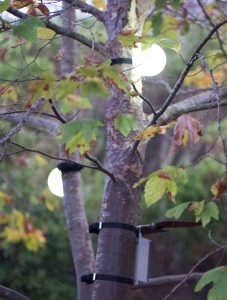
Sun Eaters, 2020
Potted plant, custom code, and electronics
Sun Eaters is an installation which renders bioelectricity visible as light through electrocardiography and custom electronics. Bioelectricity in humans results in a rhythmic pulse we understand as a heartbeat and in plants, it is rendered in a much different wave pattern. Sun Eaters combines measurements from participants with that of a tree installed in the gallery for a meeting across species. Grothaus is exploring the question of whether artworks can act as an empirical interface for understanding ecological processes. If you can visibly see your heart pulse together with a tree, will you experience a different level of connection with it?
Grace Grothaus is a computational media artist whose research-creation encompasses environmental sensing, physical computing and speculative futurity. Her projects have been exhibited widely, including the International Symposium of Electronic Art, Environmental Crisis: Art & Science in London, UK, Cité Internationale des Arts in Paris, and the World Creativity Biennale in Brazil. Grothaus has received awards for her work from organizations such as the United States National Foundation for Advancement in the Arts. Currently Grothaus is working towards a PhD in Digital Media from York University where she is a VISTA scholar and Graduate Fellow of Academic Distinction.
Gayil Nalls
World Sensorium, 1999
Olfactory scent integrated on paper square
World Sensorium, the global essence, came into physical existence at the end of 1999. It premiered at “Times Square 2000: The Global Celebration at the Crossroads of the World.” Microencapsulated paper squares, each containing 10g of World Sensorium, cascaded down over Times Square into a sea of 2 million people. Individuals pulled open the paper squares for an unprecedented participatory sensory experience. The world scent was featured around the globe and continues to be exhibited in galleries, museums, and public spaces internationally.
Note: The World Sensorium paper squares, created in 1999, are now artifacts. Each microencapsulated paper square originally carried 10 grams of World Sensorium; however, after 23 years the scent has become ephemeral.
Experience World Sensorium, 2021
Video (25 mins)
Experience World Sensorium is a documentation of New York college students from culturally diverse backgrounds engaging with World Sensorium. The unique experiences of the individuals inform the link between psychology, olfaction, and the phenomena of odor-evoked autobiographical memory. The film by Fiona Kane, is part of the ongoing efforts of Gayil Nalls to incorporate cinematic methods of data gathering, as a visual sociology, into the research of the world scent.
Gayil Nalls is an interdisciplinary artist creating at the forefront of science-art practices and theoretical discourse. She is an internationally known pioneer of olfactory art and science and is the creator of World Sensorium, the olfactory social sculpture.
Brian Harris & Raewyn Turner
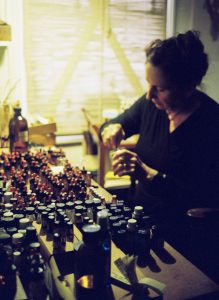
ReedRead, 2022
Fragranced vests with ochre-colored perfume, video (21 mins 58 sec)
ReedRead refers to the mythical story of a secret, surreptitiously whispered into a hole in the earth and the revealing of it by reeds that grew there and whispered in the wind. It relates to data misinterpretation, hidden secrets, and the desire for vast wealth. Data can be derived from any source including reeds rustling in the wind and may be formed into letters and words. The whispering is extracted and decoded by ReedRead and broadcast across the world. The vests, which can be worn by visitors, are colored with goethite earth resembling a shroud excavated from the material remains of the ‘Midas Mound’ tomb in the ancient kingdom of Phrygia. The vests are fragranced with an ochre-colored perfume made from Fossilized Amber Oil, Acacia Farnesiana, and Saffron.
Brian Harris trained in physics, mathematics, and electronics and has since practiced as a design engineer making mechatronic and bespoke equipment for the NZ international film industry. His motion-control and robotic inventions have been used in local and international commercials and film productions including Lord of the Rings, Utu, Once Were Warriors and many others.
Raewyn Turner is an interdisciplinary visual artist concerned with cross-sensory perception and the uncharted territories of the senses. She has worked with olfaction since 1999. Her works have been shown and presented in numerous national and international exhibitions including Performance Arcade, Spectra, Big Anxiety Festival, What Taste is the Colour Blue LA, ISEA, Synesthesia Art & Science Spain, China, 11th Prague Quadrennial, MOMA LA, Pompidou Centre, Te Papa Museum NZ. Previously she participated as a conceptual artist for the Multisensory Concerts for the Deaf (Four Senses) and was the Set and Lighting Designer for 8 years with Split Enz, ENZO and theatre productions NZ, Australia.
Hrysovalanti Fereniki Maheras
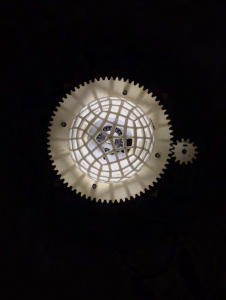
Kinetic Shadows, 2022
3D-printed sculpture, electronics, Rpi, motors, and headlights
Kinetic Shadows is a sculptural artwork, whose movement favors the embodiment of light, which is seen here as a tangible sensation. Both, the patterns of the physical form and of the light generate a series of after images, or else imaginary combinations of abstract shapes, which cannot be seen but felt on the body of the audience when in contact with the kinetic shadows. Kinetic Shadows is an experiment of stroboscopic light art focusing on synthesizing perception and taking inspiration from William S. Burrows and Brion Gysin’s experiments with the Dreamachine, an analog kinetic light sculpture that highlighted how flickering light influences the human brain’s associations of moving light with recognizable compositions of images that are unique for each experiencer. The kinetic shadows stem from the patterns designed on the form of the sculpture, which surround a digitally processed light source and rotate continuously at different speeds. While navigating the interactions unfolding in a prey-predator ecosystem, the light source pulsates dynamically in emotive states ranging from low states of valence and arousal (depression, anger) to high states (joy, serenity).
Hrysovalanti Fereniki Maheras is a PhD student in Digital Media at York University and she is studying with Dr. Mark-David Hosale as a researcher at nD::StudioLab. She holds a B.A. Hons in Media Arts from Plymouth University, UK and an M.A. in Digital Media from York University, CA. In her research, she speculates on the innovation of computational machines as emotional beings, as she navigates the connections between the philosophical theories written about the human soul, and the cybernetic theories and artworks created for the exploration of the mind of technology. Her practice emphasizes on the creation of groups of electronic sound/kinetic sculptures that act as artificially living communities. Traversing between the virtual and the physical world, she explores the creation of a virtual analog environment emerging in a shared complex physical habitat.
Guy Van Belle
Fanfara, 2022
Documentary video of live performance on loop
Fanfara is a collaborative work between Guy Van Belle, Krzysztof Topolski, and the Gdańsk University Choir. A sound score gives an indication of discrete and continuous time, pitches and amplitudes, complexities and silences, and combinatory ideas in the form of sounds you can listen to, sing, counter, imitate, or enrich. The performance consists of a composition with recorded and computer generated birdsongs, transmitted over local FM, received by the musicians on headsets who ‘sing’ along with the birdsongs. The singers move slowly together with the musicians and participatory audience resonating and influencing the position of the group.
Guy van Belle, composer and experimental artist, divides his time between the Czech Republic and Belgium. He investigates many different forms of creativity including synaesthetic, real time generated, abstract, algorithmic, gradually abandoning the familiar formats as we know them today. He is the co-founder of the artists-run centre OKNO. Between 2005 and 2009 he lived in Bratislava, where he began to work under the name of Gívan Belá and explore a more eco(techno)logical and environmental approach within media arts.
Symposium Speakers
Ryszard W. Kluszczyński
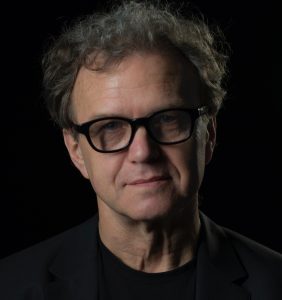
Ryszard W. Kluszczyński, PhD, media art scholar, writer and curator.
Chair of Department of New Media and Digital Culture, University of Lodz, Poland. Professor at the Academy of Fine Arts in Lodz. Investigates the issues of new media arts and cyberculture, contemporary art theory and practices, avant-gardes, transdisciplinary cultural transformations, and recent interactions between art, science, technology and politics. Artistic Director of Art + Science Meeting Program in the Centre for Contemporary Art in Gdansk (2011–). Chief Curator of Film, Video and Multimedia Arts in the Centre for Contemporary Art – Ujazdowski Castle in Warsaw (1990-2001).
Some of his recent book publications: Towards a Non-Anthropocentric Ecology. Victoria Vesna and Art in the World of Anthropocene (2020); Beyond Borders: Processed Body – Expanded Brain – Distributed Agency (2019); Augmenting the World. Masaki Fujihata and Hybrid Space-Time Art (2017).
David Howes
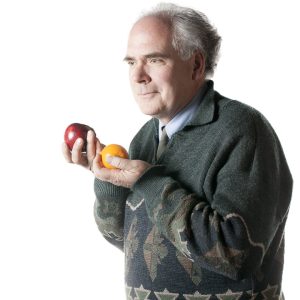
David Howes is a Professor of Anthropology and Co-Director of the Centre for Sensory Studies at Concordia University, and an Adjunct Professor in the Faculty of Law at McGill University, Montreal. He is a pioneer of the anthropology of the senses and a leading theorist in the interdisciplinary field of sensory studies. He also writes on aesthetics and material culture, and on comparative law, legal pluralism and the theory of cross-cultural jurisprudence. Howes has conducted field research on the social and cultural life of the senses in Papua New Guinea, Northwestern Argentina, and the Southwestern United States. He recently concluded a research project on “Law and the Regulation of the Senses” and is currently directing a project entitled “Explorations in Sensory Design.” Howes’s latest publications include the four-volume Senses and Sensation: Critical and Primary Sources compendium (2018) and “The Sensory Studies Manifesto: Tracking the Sensorial Revolution in the Arts and Human Sciences” due out from the University of Toronto Press this October. http://www.sensorystudies.org/ http://centreforsensorystudies.org/
Chris Salter
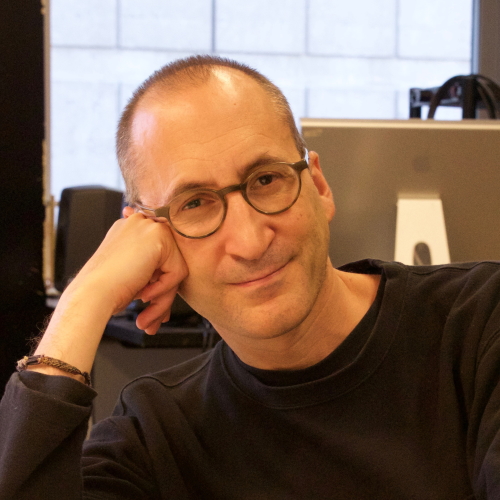
Chris Salter is Professor for Immersive Arts and Director of the Immersive Arts Space at the Zurich University of the Arts (ZHdK). He is also Professor Emeritus, Design and Computation Arts at Concordia University in Montreal and former co-director of the Hexagram network for research-creation in arts, cultures and technology. He studied philosophy, economics, theatre and computer music at Emory and Stanford Universities. His artistic work has been seen all over the world at such venues as the Venice Architecture Biennale, Barbican Centre, Berliner Festspiele, Wiener Festwochen, ZKM, Kunstfest Weimar, Musée d’art Contemporain, EXIT Festival and Place des Arts-Montreal, among many others. He is the author of Entangled: Technology and the Transformation of Performance (MIT Press, 2010), Alien Agency: Experimental Encounters with Art in the Making (MIT Press 2015) and Sensing Machines (MIT Press 2022).
Katarzyna Słoboda
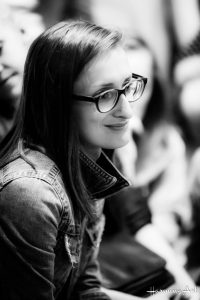
Katarzyna Słoboda is a curator and researcher. She has a PhD in humanities from the Institute of Art at the Polish Academy of Sciences in Warsaw. Between August 2009 and September 2022 she worked at Museum of Art in Łódź, where she has curated such exhibitions as You come, we will show you what we do. On dance improvisation (2013, with Sonia Nieśpiałowska-Owczarek), Frames of reference. Choreography in the Museum (2016, with Mateusz Szymanówka), Moved Bodies. Choreographies of Modernity (2016) or Prototypes 4: Agata Siniarska, Land(slip) (2020) among others. She has (co-)edited and written publications on dance, choreography, contemporary and modern art. A recipient of Grażyna Kulczyk research scholarship in the field of contemporary choreography and Młoda Polska 2018. Guest lecturer at the Institute of Contemporary Culture (University of Łódź). https://kasiasloboda.cargo.site/
Hilda Kozári
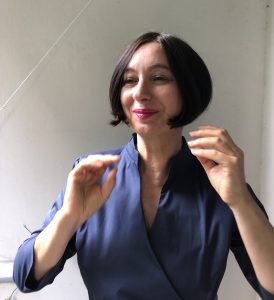
Visual artist Hilda Kozári is based in Helsinki Finland. Kozári has been developing multisensory and participatory presentation in visual art including olfactory sense. Culture-bound senses and spatial memory as part of identity are recurrent features of her multisensory artworks. Collaboration with scientists and artists from different fields, workshops, discussions and social, urban projects are important parts of Kozári’s work. Her projects with visually impaired have mutual effects on her exhibitions and public art. Since 1991, Kozári has exhibited in galleries, museums and public and private spaces internationally. Her most recognized installation AIR, Smell of Helsinki, Budapest and Paris (2003) and some other works are in the collection of Museum of Contemporary Art Kiasma, Finnish National Gallery. Kozári has also public artworks in parks in the cities of Helsinki, Vantaa and Jyväskylä.
Csenge Kolozsvari

Csenge Kolozsvari‘s interdisciplinary practice explores the body’s potential as a membrane for being active between thought, movement and sound; a translucent and permeable substance that resonates both with the constantly changing surrounding and the conceiving forces within. Working with the materiality of digital media (sound, video) and the performativity of mundane material and aesthetic choices, she has been cultivating listening and somatic practices as ways of making sense of the world; a live practice of process-making and form-taking.
Agnieszka Sorokowska
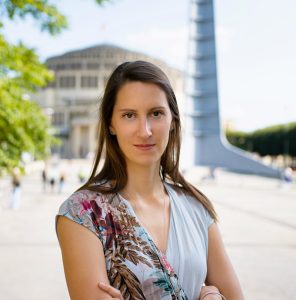
Agnieszka Sorokowska works as an associate professor at the Institute of Psychology (University of Wroclaw) where she is a head of the Smell and Taste Research Lab. Her previous affiliations include Technische Universitaet Dresden and Stockholm University. She is an author or coauthor of over 100 publications in international scientific journals (including Nature, Cognition, Personality and Social Psychology Bulletin and Psychological Science). Multidisciplinary research program of Agnieszka Sorokowska and her team relates mostly to sensory perception, cross-cultural and cognitive psychology, although many of her studies also combine other disciplines, like anthropology or neuroscience. She conducted studies in West Papua, Bolivian Amazon or Pacific Islands. Together with Piotr Sorokowski, she is a leader of the Cross-Cultural Research Group that comprises over 100 scientists from all over the world and regularly publishes the outcomes of their studies in top scientific journals.
Doug Van Nort
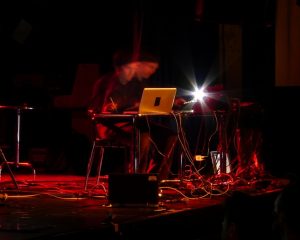
Doug Van Nort’s creative and scholarly work operates in the domains of electroacoustic, experimental and computer music, improvised and interactive performance, and the sonic arts more broadly. Spanning from professional music to public installation and workshop contexts, he creates compositions and frameworks for improvisation that integrate machine agents, immersive environments, interactive systems and experiences of telepresence as boundary conditions to explore the myriad ways that performers negotiate emergent, collective meaning outside of spoken language.
Katarzyna Pastuszak
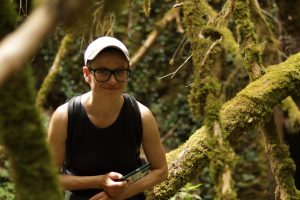
Katarzyna Pastuszak (Poland, PhD) – dancer/performer, choreographer and artistic director of Amareya Theatre & Guests, adjunct, and lecturer at the Department of Performing Arts (IAiA – University of Gdańsk), member of Between.Pomiędzy Research Group (UG), adjunct professor of the CEMiPoS. Author of the book “Hijikata Tatsumi’s Ankoku butō – the theatre of body-in-crisis (2014). She works in the field of new choreography and physical theatre, combining movement explorations with the contemporary currents of humanist thought. She is interested in the politicality of the body and choreography. She works with ethnic minorities and groups at risk of exclusion. The kingdom of fungi occupies a special place in her artistic practice. Her recent activities: “Re:fungium” PaR project (2022), dance/art film “Home” (dir. Sue Schroeder, 2022); performance “Anatomies” (Natalia Chylińska, Katarzyna Pastuszak/premiere at YPAM Tokyo, Japan 2021); performance 家–逃亡–家 (Home-Run-Home, 2020). She also collaborates with Park ON Association (Poland) – conducting dance workshops for PD patients.

